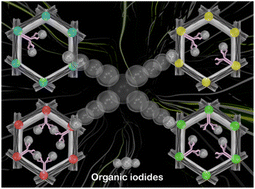Unraveling mechanistic insights into covalent organic frameworks for highly efficient sequestration of organic iodides from simulated nuclear waste†
Abstract
Over the last few decades, given the impending global energy and environmental crises, paramount development in nuclear energy as an alternative high power density and low-carbon energy source has been widely observed. However, this development is hindered due to certain problems associated with nuclear reactors, including the emission of volatile radioactive substances, like organic iodides and iodine, which must be eliminated before releasing the off-gas. These substances include methyl iodide (CH3I), ethyl iodide (CH3CH2I), and iodine, which are exceedingly harmful to both the environment and human health. Although several porous solid adsorbents have been successfully employed to sequester organic iodides (generally CH3I) from the vapor phase, the majority of the earlier investigations have largely focused on the saturation capacity and kinetic study of CH3I capture. However, the importance of the porous adsorbents' strategic functions in the unique binding interaction with organic iodides has been grossly underappreciated and poorly understood. Also, certain crucial difficulties pertaining to the practical capturing of radioactive organic iodides from nuclear waste were thwarted in the endeavors to construct innovative adsorbents. Herein, we have demonstrated a systematic strategy-driven study to understand the roles of framework-integrated functionalities towards organic iodide sequestration by varying the number of N-heteroatomic sites in a series of chemically stable porous covalent organic frameworks (COFs). The CH3I adsorption capacity was found to be positively correlated with the porosity or surface area as well as with the N-heteroatomic or heterocyclic functionalities, such as the imine, pyridine, and triazine sites of these COFs. Under both static and dynamic conditions, all the COFs exhibited high CH3I sorption capacities through the N-methylation reaction mechanism. This work is of fundamental importance to understanding the CH3I adsorption mechanisms and also offers direction for the design and development of novel adsorbents for relevant applications.



 Please wait while we load your content...
Please wait while we load your content...